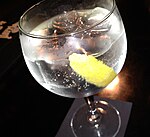food.wikisort.org - Beverage
Sangrita (meaning "little blood"), is a Mexican non-alcoholic drink often served with tequila - customarily a shot of tequila Blanco. Its origin dates back to the 1920s.[citation needed]
 | |
| Type | Drink |
|---|---|
| Country of origin | Jalisco, Mexico |
| Colour | Red |
| Ingredients | Orange juice, lime juice, chili sauce |
This article has multiple issues. Please help improve it or discuss these issues on the talk page. (Learn how and when to remove these template messages)
|
It serves to complement the flavor of 100% agave tequila, which is similarly reminiscent of peppers and citrus. The peppery taste highlights tequila's crisp acidity and cleanses the palate. Before increased worldwide popularity and corporate interest in tequila in the late 1990s, consumption was largely localized to the vicinity of the tequila-producing state of Jalisco.
A popular recipe in Guadalajara, Jalisco's largest city, was said to have originated from the leftover juices (mainly orange) of an equally popular regional fruit salad covered with fine chili powder, usually piquin. As the fruit salad, known to jalisquillos (Guadalajara's natives) as pico de gallo, was consumed from a large bowl during breakfast, the remaining juice was saved and poured on a small and narrow clay cup, which itself would be the precursor of the tequila shot glass.
In almost all cases the drink took its bright red color from a mix of the fine pepper powder, spices, and pomegranate, while the base was mainly orange or sweetened lime juice. The key to a balanced sangrita recipe can be found in the fruit salad's recipes, which would have included any or all of the following: tangerine, cucumber, papaya, mango and jicama.[1]
Traditionally, sangrita is served with tequila blanco, but it can also accompany tequila reposado. The tequila and sangrita are each poured into a separate shot glass (or caballito) and the two are alternately sipped, not chased. Sangrita is used in a drink known as "The Mexican Flag", where three separate double shot glasses are filled with lime juice, tequila and sangrita.[2]
Ingredients
Authentic sangrita from the Lake Chapala region of Jalisco is made with Seville orange, lime and pomegranate juices, with chili powder or hot sauce added for heat. However, most modern sangrita recipes (particularly outside of Jalisco) have mistakenly attributed the red appearance of the drink to tomato juice instead of the chile powder. While some would argue that there is no set rule on what sangrita should contain, as the main ingredient, it is commonly considered by older residents of Jalisco that tomato and particularly branded recipes such as the "Clamato" mix stem from uninformed efforts to recreate the drink due to its growing popularity. It can feature a blend of orange, lime, tomato and/or pomegranate juices, or pomegranate-based grenadine with the addition of something spicy (hot sauce or fresh/dried Chili pepper), and sometimes white onion and salt.[3]
A variation on a basic traditional recipe:
- 1 oz. freshly squeezed orange juice
- 3/4 to 1 oz. freshly squeezed lime juice
- 1/2 oz. real pomegranate-based grenadine
- 1/4 tsp. ancho chile powder or 3 dashes of hot sauce
- 1-2 slices jalapeño[4]
A basic tomato based recipe (non-traditional)
- 2 parts freshly squeezed tomato juice
- 1 part freshly squeezed orange juice
- 1/2 part freshly squeezed lime juice
- Fresh minced green chile to taste[5]
Mexico City-style Sangrita:
- 5 parts tomato juice
- 2 parts fresh lime juice
- 1 part orange juice
- Seasoned with a combination of Jugo Maggi, Salsa Valentina, Worcestershire, and Tabasco(original) sauce to taste.[citation needed]
References
- Elayne Duff (2011-06-24). "Tequila and the cocktails that made it famous".
{{cite journal}}: Cite journal requires|journal=(help) - "Just About Everything You Will Need To Know About Tequila". Be A Better Bartender. 2014-08-17. Retrieved 2022-10-24.
- Morgenthaler, Jeffrey (2008-06-10). "How to Make Sangrita". Jeffrey Morgenthaler. Retrieved 2022-10-24.
- Morgenthaler, Jeffrey (2008-06-10). "How to Make Sangrita". Jeffrey Morgenthaler. Retrieved 2022-10-24.
- "Sangrita Recipe". Liquor.com. Retrieved 2022-10-24.
На других языках
- [en] Sangrita
[ru] Сангрита
Сангри́та (исп. Sangrita) — мексиканский безалкогольный напиток с ярко выраженным кисло-острым вкусом, которым запивают текилу[1]. Название можно перевести на русский буквально как «кровушка» или «кровинка». Основная концепция сангриты заключается в том, чтобы дополнить вкус текилы и очистить нёбо между глотками алкогольного напитка.Другой контент может иметь иную лицензию. Перед использованием материалов сайта WikiSort.org внимательно изучите правила лицензирования конкретных элементов наполнения сайта.
WikiSort.org - проект по пересортировке и дополнению контента Википедии
